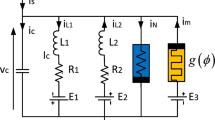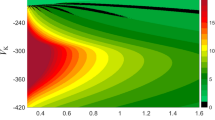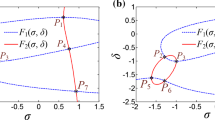Abstract
A change in neuronal-action potential can generate a magnetically induced current during the release and propagation of intracellular ions. To better characterize the electromagnetic-induction effect, this paper presents an improved discrete Rulkov (ID-Rulkov) neuron model by coupling a discrete model of a memristor with sine memductance into a discrete Rulkov neuron model. The ID-Rulkov neuron model possesses infinite invariant points, and its memristor-induced stability effect is evaluated by detecting the routes of period-doubling and Neimark-Sacker bifurcations. We investigated the memristor-induced dynamic effects on the neuron model using bifurcation plots and firing patterns. Meanwhile, we theoretically expounded the memristor initial-boosting mechanism of infinite coexisting patterns. The results show that the ID-Rulkov neuron model can realize diverse neuron firing patterns and produce hyperchaotic attractors that are nondestructively boosted by the initial value of the memristor, indicating that the introduced memristor greatly benefits the original neuron model. The hyperchaotic attractors initially boosted by the memristor were verified by hardware experiments based on a hardware platform. In addition, pseudorandom number generators are designed using the ID-Rulkov neuron model, and their high randomness is demonstrated based onstrict test results.
Similar content being viewed by others
References
Shilnikov A L, Rulkov N F. Origin of chaos in a two-dimensional map modeling spiking-bursting neural activity. Int J Bifurcation Chaos, 2003, 13: 3325–3340
Hodgkin A L, Huxley A F. A quantitative description of membrane current and its application to conduction and excitation in nerve. J Physiol, 1952, 117: 500–544
Rajamani V, Kim H, Chua L. Morris-Lecar model of third-order barnacle muscle fiber is made of volatile memristors. Sci China Inf Sci, 2018, 61: 060426
Chua L. If it’s pinched it’s a memristor. Semicond Sci Technol, 2014, 29: 104001
Eshraghian K, Kavehei O, Cho K R, et al. Memristive device fundamentals and modeling: Applications to circuits and systems simulation. Proc IEEE, 2012, 100: 1991–2007
Bao H, Chen Z G, Cai J M, et al. Memristive cyclic three-neuron-based neural network with chaos and global coexisting attractors. Sci China Tech Sci, 2022, 65: 2582–2592
Chen C, Min F, Zhang Y, et al. Memristive electromagnetic induction effects on Hopfield neural network. Nonlinear Dyn, 2021, 106: 2559–2576
Ma J, Yang Z, Yang L, et al. A physical view of computational neurodynamics. J Zhejiang Univ Sci A, 2019, 20: 639–659
Corinto F, Forti M. Memristor circuits: Bifurcations without parameters. IEEE Trans Circuits Syst I, 2017, 64: 1540–1551
Hong Q, Chen H, Sun J, et al. Memristive circuit implementation of a self-repairing network based on biological astrocytes in robot application. IEEE Trans Neural Netw Learn Syst, 2022, 33: 2106–2120
Li K, Bao H, Li H, et al. Memristive rulkov neuron model with magnetic induction effects. IEEE Trans Ind Inf, 2022, 18: 1726–1736
Zhong Y, Tang J, Li X, et al. Dynamic memristor-based reservoir computing for high-efficiency temporal signal processing. Nat Commun, 2021, 12: 408
Hua L, Zhu H, Shi K, et al. Novel finite-time reliable control design for memristor-based inertial neural networks with mixed time-varying delays. IEEE Trans Circuits Syst I, 2021, 68: 1599–1609
Mannan Z I, Adhikari S P, Yang C, et al. Memristive imitation of synaptic transmission and plasticity. IEEE Trans Neural Netw Learn Syst, 2019, 30: 3458–3470
Kumar S, Strachan J P, Williams R S. Chaotic dynamics in nanoscale NbO2 Mott memristors for analogue computing. Nature, 2017, 548: 318–321
Lin P, Li C, Wang Z, et al. Three-dimensional memristor circuits as complex neural networks. Nat Electron, 2020, 3: 225–232
Bilotta E, Pantano P, Vena S. Speeding up cellular neural network processing ability by embodying memristors. IEEE Trans Neural Netw Learn Syst, 2017, 28: 1228–1232
Lv M, Wang C, Ren G, et al. Model of electrical activity in a neuron under magnetic flow effect. NOnlinear Dyn, 2016, 85: 1479–1490
Ma J, Tang J. A review for dynamics in neuron and neuronal network. Nonlinear Dyn, 2017, 89: 1569–1578
Bao B C, Zhu Y X, Ma J, et al. Memristive neuron model with an adapting synapse and its hardware experiments. Sci China Tech Sci, 2021, 64: 1107–1117
Ge M, Jia Y, Xu Y, et al. Mode transition in electrical activities of neuron driven by high and low frequency stimulus in the presence of electromagnetic induction and radiation. Nonlinear Dyn, 2018, 91: 515–523
Bao H, Gu Y, Xu Q, et al. Parallel bi-memristor hyperchaotic map with extreme multistability. Chaos Solitons Fractals, 2022, 160: 112273
Li H, Hua Z, Bao H, et al. Two-dimensional memristive hyperchaotic maps and application in secure communication. IEEE Trans Ind Electron, 2021, 68: 9931–9940
Bao H, Hua Z, Li H, et al. Discrete memristor hyperchaotic maps. IEEE Trans Circuits Syst I, 2021, 68: 4534–4544
Rulkov N F. Modeling of spiking-bursting neural behavior using two-dimensional map. Phys Rev E, 2002, 65: 041922
Rulkov N F. Regularization of synchronized chaotic bursts. Phys Rev Lett, 2001, 86: 183–186
Wagemakers A, Sanjuán M A F. Electronic circuit implementation of the chaotic Rulkov neuron model. J Franklin Institute, 2013, 350: 2901–2910
Bao H, Liu W, Ma J, et al. Memristor initial-offset boosting in memristive HR neuron model with hidden firing patterns. Int J Bifurcation Chaos, 2020, 30: 2030029
Kim J, Pershin Y V, Yin M, et al. An experimental proof that resistance-switching memory cells are not memristors. Adv Electron Mater, 2020, 6: 2000010
Pershin Y V, Kim J, Datta T, et al. An experimental demonstration of the memristor test. Physica E, 2022, 142: 115290
Lu L L, Yi M, Liu X Q. Energy-efficient firing modes of chay neuron model in different bursting kinetics. Sci China Tech Sci, 2022, 65: 1661–1674
Lv M, Ma J, Yao Y G, et al. Synchronization and wave propagation in neuronal network under field coupling. Sci China Tech Sci, 2019, 62: 448–457
Bao H, Chen M, Wu H G, et al. Memristor initial-boosted coexisting plane bifurcations and its extreme multi-stability reconstitution in two-memristor-based dynamical system. Sci China Tech Sci, 2020, 63: 603–613
Bandt C, Pompe B. Permutation entropy: A natural complexity measure for time series. Phys Rev Lett, 2002, 88: 174102
Theiler J. Efficient algorithm for estimating the correlation dimension from a set of discrete points. Phys Rev A, 1987, 36: 4456–4462
Bakiri M, Guyeux C, Couchot J F, et al. A hardware and secure pseudorandom generator for constrained devices. IEEE Trans Ind Inf, 2018, 14: 3754–3765
Rukhin A L, Soto J, Nechvatal J, et al. A statistical test suite for random and pseudorandom number generators for cryptographic applications. Special Publication (NIST SP). Gaithersburg: National Institute of Standards and Technology, 2010
Rong K, Bao H, Li H, et al. Memristive Hénon map with hidden Neimark-Sacker bifurcations. Nonlinear Dyn, 2022, 108: 4459–4470
Jiang H, Liu Y, Wei Z, et al. A new class of two-dimensional chaotic maps with closed curve fixed points. Int J Bifurcation Chaos, 2019, 29: 1950094
Jiang H, Liu Y, Wei Z, et al. Hidden chaotic attractors in a class of two-dimensional maps. Nonlinear Dyn, 2016, 85: 2719–2727
Panahi S, Sprott J C, Jafari S. Two simplest quadratic chaotic maps without equilibrium. Int J Bifurcation Chaos, 2018, 28: 1850144
Bao H, Hua Z Y, Liu W B, et al. Discrete memristive neuron model and its interspike interval-encoded application in image encryption. Sci China Tech Sci, 2021, 64: 2281–2291
Hua Z Y, Zhou B H, Zhang Y X, et al. Modular chaotification model with FPGA implementation. Sci China Tech Sci, 2021, 64: 1472–1484
Zhang L, Chen Z, Rao W, et al. Efficient and secure non-coherent ofdm-based overlapped chaotic chip position shift keying system: Design and performance analysis. IEEE Trans Circuits Syst I, 2020, 67: 309–321
Bao H, Hua Z, Li H, et al. Memristor-based hyperchaotic maps and application in auxiliary classifier generative adversarial nets. IEEE Trans Ind Inf, 2022, 18: 5297–5306
Author information
Authors and Affiliations
Corresponding author
Additional information
This work was supported by the National Natural Science Foundation of China (Grant Nos. 62271088 and 62201094) and the Scientific Research Foundation of Jiangsu Provincial Education Department, China (Grant No. 22KJB510001).
Rights and permissions
About this article
Cite this article
Bao, H., Li, K., Ma, J. et al. Memristive effects on an improved discrete Rulkov neuron model. Sci. China Technol. Sci. 66, 3153–3163 (2023). https://doi.org/10.1007/s11431-023-2432-1
Received:
Accepted:
Published:
Issue Date:
DOI: https://doi.org/10.1007/s11431-023-2432-1




